江苏省无锡市普通高中2018届高三上学期期末考试英语试题+扫描版含答案
- 格式:doc
- 大小:13.53 MB
- 文档页数:14
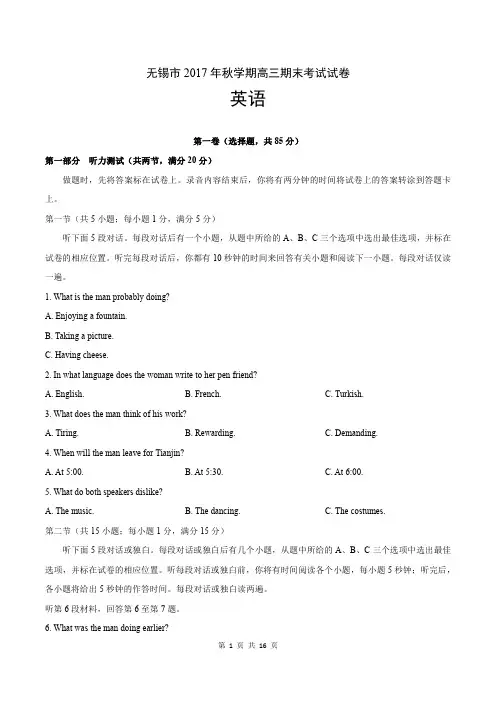
无锡市2017年秋学期高三期末考试试卷英语第一卷(选择题,共85分)第一部分听力测试(共两节,满分20分)做题时,先将答案标在试卷上。
录音内容结束后,你将有两分钟的时间将试卷上的答案转涂到答题卡上。
第一节(共5小题;每小题1分,满分5分)听下面5段对话。
每段对话后有一个小题,从题中所给的A、B、C三个选项中选出最佳选项,并标在试卷的相应位置。
听完每段对话后,你都有10秒钟的时间来回答有关小题和阅读下一小题。
每段对话仅读一遍。
1.What is the man probably doing?A.Enjoying a fountain.B.Taking a picture.C.Having cheese.2.In what language does the woman write to her pen friend?A.English.B.French.C.Turkish.3.What does the man think of his work?A.Tiring.B.Rewarding.C.Demanding.4.When will the man leave for Tianjin?A.At5:00.B.At5:30.C.At6:00.5.What do both speakers dislike?A.The music.B.The dancing.C.The costumes.第二节(共15小题;每小题1分,满分15分)听下面5段对话或独白。
每段对话或独白后有几个小题,从题中所给的A、B、C三个选项中选出最佳选项,并标在试卷的相应位置。
听每段对话或独白前,你将有时间阅读各个小题,每小题5秒钟;听完后,各小题将给出5秒钟的作答时间。
每段对话或独白读两遍。
听第6段材料,回答第6至第7题。
6.What was the man doing earlier?A.Swimming in a pool.B.Taking a shower.C.Running outside.7.What will the woman probably do next?A.Wash clothes.B.Get something to drink.C.Look for her brown shorts.听第7段材料,回答第8至第9题。
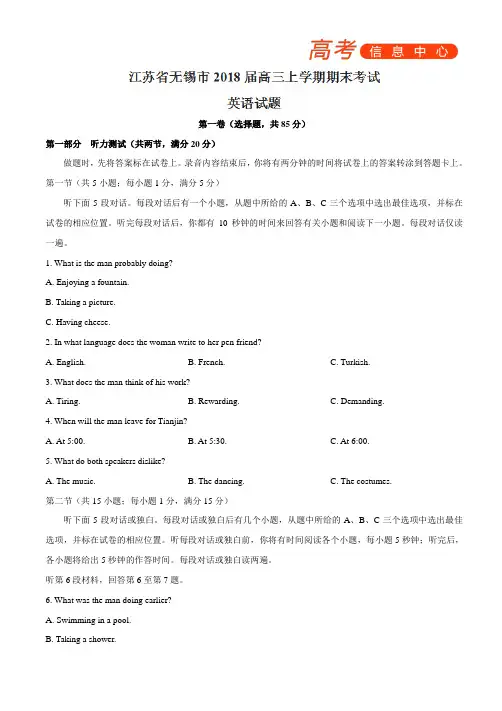
第一卷(选择题,共85分)第一部分听力测试(共两节,满分20分)做题时,先将答案标在试卷上。
录音内容结束后,你将有两分钟的时间将试卷上的答案转涂到答题卡上。
第一节(共5小题;每小题1分,满分5分)听下面5段对话。
每段对话后有一个小题,从题中所给的A、B、C三个选项中选出最佳选项,并标在试卷的相应位置。
听完每段对话后,你都有10秒钟的时间来回答有关小题和阅读下一小题。
每段对话仅读一遍。
1. What is the man probably doing?A. Enjoying a fountain.B. Taking a picture.C. Having cheese.2. In what language does the woman write to her pen friend?A. English.B. French.C. Turkish.3. What does the man think of his work?A. Tiring.B. Rewarding.C. Demanding.4. When will the man leave for Tianjin?A. At 5:00.B. At 5:30.C. At 6:00.5. What do both speakers dislike?A. The music.B. The dancing.C. The costumes.第二节(共15小题;每小题1分,满分15分)听下面5段对话或独白。
每段对话或独白后有几个小题,从题中所给的A、B、C三个选项中选出最佳选项,并标在试卷的相应位置。
听每段对话或独白前,你将有时间阅读各个小题,每小题5秒钟;听完后,各小题将给出5秒钟的作答时间。
每段对话或独白读两遍。
听第6段材料,回答第6至第7题。
6. What was the man doing earlier?A. Swimming in a pool.B. Taking a shower.C. Running outside.7. What will the woman probably do next?A. Wash clothes.B. Get something to drink.C. Look for her brown shorts.听第7段材料,回答第8至第9题。
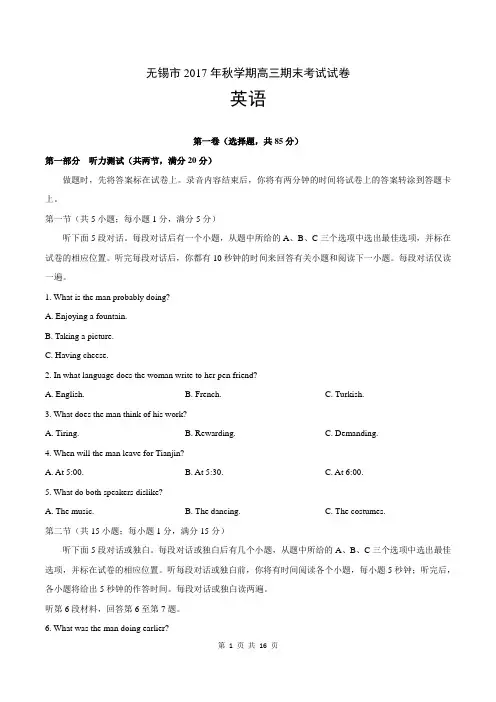
无锡市2017年秋学期高三期末考试试卷英语第一卷(选择题,共85分)第一部分听力测试(共两节,满分20分)做题时,先将答案标在试卷上。
录音内容结束后,你将有两分钟的时间将试卷上的答案转涂到答题卡上。
第一节(共5小题;每小题1分,满分5分)听下面5段对话。
每段对话后有一个小题,从题中所给的A、B、C三个选项中选出最佳选项,并标在试卷的相应位置。
听完每段对话后,你都有10秒钟的时间来回答有关小题和阅读下一小题。
每段对话仅读一遍。
1. What is the man probably doing?A. Enjoying a fountain.B. Taking a picture.C. Having cheese.2. In what language does the woman write to her pen friend?A. English.B. French.C. Turkish.3. What does the man think of his work?A. Tiring.B. Rewarding.C. Demanding.4. When will the man leave for Tianjin?A. At 5:00.B. At 5:30.C. At 6:00.5. What do both speakers dislike?A. The music.B. The dancing.C. The costumes.第二节(共15小题;每小题1分,满分15分)听下面5段对话或独白。
每段对话或独白后有几个小题,从题中所给的A、B、C三个选项中选出最佳选项,并标在试卷的相应位置。
听每段对话或独白前,你将有时间阅读各个小题,每小题5秒钟;听完后,各小题将给出5秒钟的作答时间。
每段对话或独白读两遍。
听第6段材料,回答第6至第7题。
6. What was the man doing earlier?A. Swimming in a pool.B. Taking a shower.C. Running outside.7. What will the woman probably do next?A. Wash clothes.B. Get something to drink.C. Look for her brown shorts.听第7段材料,回答第8至第9题。
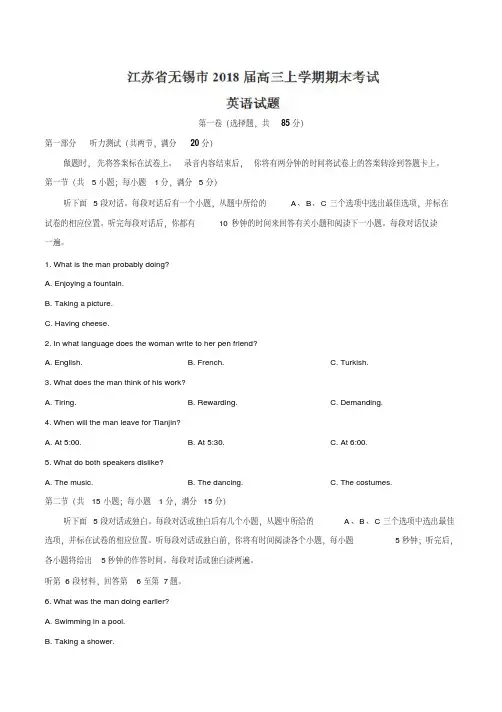
第一卷(选择题,共85分)第一部分听力测试(共两节,满分20分)做题时,先将答案标在试卷上。
录音内容结束后,你将有两分钟的时间将试卷上的答案转涂到答题卡上。
第一节(共5小题;每小题1分,满分5分)听下面5段对话。
每段对话后有一个小题,从题中所给的A、B、C三个选项中选出最佳选项,并标在试卷的相应位置。
听完每段对话后,你都有10秒钟的时间来回答有关小题和阅读下一小题。
每段对话仅读一遍。
1. What is the man probably doing?A. Enjoying a fountain.B. Taking a picture.C. Having cheese.2. In what language does the woman write to her pen friend?A. English.B. French.C. Turkish.3. What does the man think of his work?A. Tiring.B. Rewarding.C. Demanding.4. When will the man leave for Tianjin?A. At 5:00.B. At 5:30.C. At 6:00.5. What do both speakers dislike?A. The music.B. The dancing.C. The costumes.第二节(共15小题;每小题1分,满分15分)听下面5段对话或独白。
每段对话或独白后有几个小题,从题中所给的A、B、C三个选项中选出最佳选项,并标在试卷的相应位置。
听每段对话或独白前,你将有时间阅读各个小题,每小题5秒钟;听完后,各小题将给出5秒钟的作答时间。
每段对话或独白读两遍。
听第6段材料,回答第6至第7题。
6. What was the man doing earlier?A. Swimming in a pool.B. Taking a shower.C. Running outside.7. What will the woman probably do next?A. Wash clothes.B. Get something to drink.C. Look for her brown shorts.听第7段材料,回答第8至第9题。
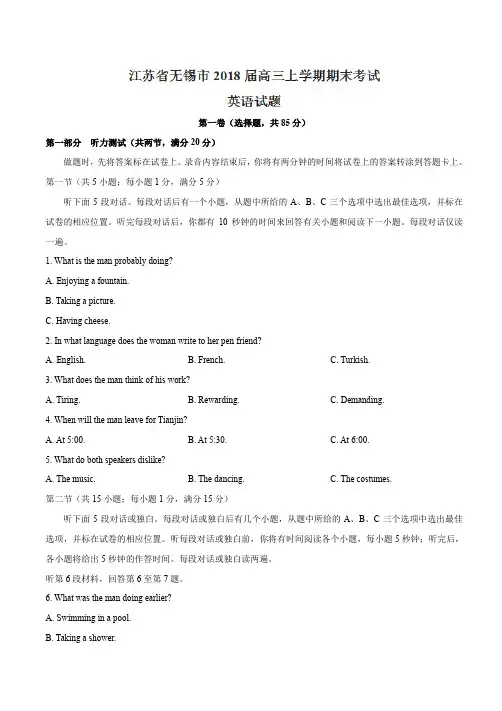
第一卷(选择题,共85分)第一部分听力测试(共两节,满分20分)做题时,先将答案标在试卷上。
录音内容结束后,你将有两分钟的时间将试卷上的答案转涂到答题卡上。
第一节(共5小题;每小题1分,满分5分)听下面5段对话。
每段对话后有一个小题,从题中所给的A、B、C三个选项中选出最佳选项,并标在试卷的相应位置。
听完每段对话后,你都有10秒钟的时间来回答有关小题和阅读下一小题。
每段对话仅读一遍。
1. What is the man probably doing?A. Enjoying a fountain.B. Taking a picture.C. Having cheese.2. In what language does the woman write to her pen friend?A. English.B. French.C. Turkish.3. What does the man think of his work?A. Tiring.B. Rewarding.C. Demanding.4. When will the man leave for Tianjin?A. At 5:00.B. At 5:30.C. At 6:00.5. What do both speakers dislike?A. The music.B. The dancing.C. The costumes.第二节(共15小题;每小题1分,满分15分)听下面5段对话或独白。
每段对话或独白后有几个小题,从题中所给的A、B、C三个选项中选出最佳选项,并标在试卷的相应位置。
听每段对话或独白前,你将有时间阅读各个小题,每小题5秒钟;听完后,各小题将给出5秒钟的作答时间。
每段对话或独白读两遍。
听第6段材料,回答第6至第7题。
6. What was the man doing earlier?A. Swimming in a pool.B. Taking a shower.C. Running outside.7. What will the woman probably do next?A. Wash clothes.B. Get something to drink.C. Look for her brown shorts.听第7段材料,回答第8至第9题。
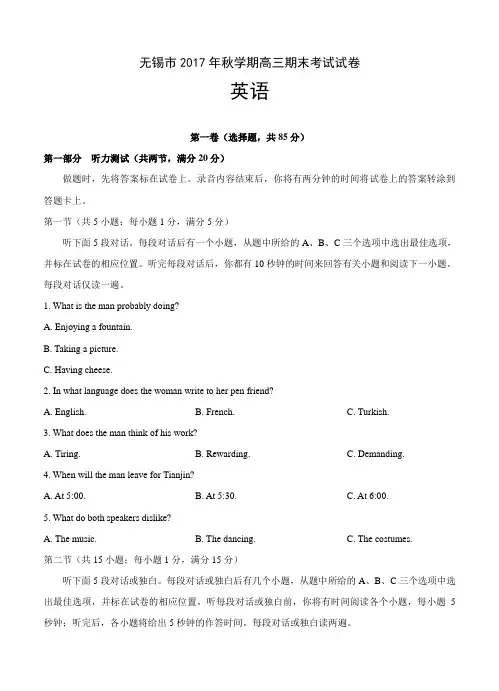
无锡市2017年秋学期高三期末考试试卷英语第一卷(选择题,共85分)第一部分听力测试(共两节,满分20分)做题时,先将答案标在试卷上。
录音内容结束后,你将有两分钟的时间将试卷上的答案转涂到答题卡上。
第一节(共5小题;每小题1分,满分5分)听下面5段对话。
每段对话后有一个小题,从题中所给的A、B、C三个选项中选出最佳选项,并标在试卷的相应位置。
听完每段对话后,你都有10秒钟的时间来回答有关小题和阅读下一小题。
每段对话仅读一遍。
1. What is the man probably doing?A. Enjoying a fountain.B. Taking a picture.C. Having cheese.2. In what language does the woman write to her pen friend?A. English.B. French.C. Turkish.3. What does the man think of his work?A. Tiring.B. Rewarding.C. Demanding.4. When will the man leave for Tianjin?A. At 5:00.B. At 5:30.C. At 6:00.5. What do both speakers dislike?A. The music.B. The dancing.C. The costumes.第二节(共15小题;每小题1分,满分15分)听下面5段对话或独白。
每段对话或独白后有几个小题,从题中所给的A、B、C三个选项中选出最佳选项,并标在试卷的相应位置。
听每段对话或独白前,你将有时间阅读各个小题,每小题5秒钟;听完后,各小题将给出5秒钟的作答时间。
每段对话或独白读两遍。
听第6段材料,回答第6至第7题。
6. What was the man doing earlier?A. Swimming in a pool.B. Taking a shower.C. Running outside.7. What will the woman probably do next?A. Wash clothes.B. Get something to drink.C. Look for her brown shorts.听第7段材料,回答第8至第9题。
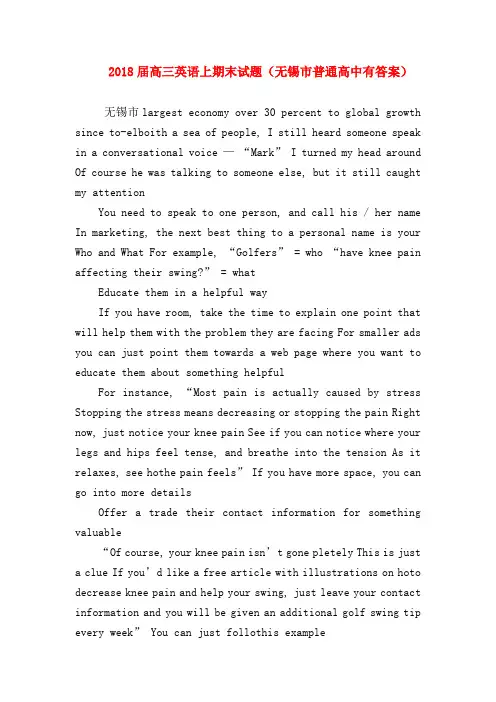
2018届高三英语上期末试题(无锡市普通高中有答案)无锡市largest economy over 30 percent to global growth since to-elboith a sea of people, I still heard someone speak in a conversational voice —“Mark” I turned my head around Of course he was talking to someone else, but it still caught my attentionYou need to speak to one person, and call his / her name In marketing, the next best thing to a personal name is your Who and What For example, “Golfers” = who “have knee pain affecting their swing?” = whatEducate them in a helpful wayIf you have room, take the time to explain one point that will help them with the problem they are facing For smaller ads you can just point them towards a web page where you want to educate them about something helpfulFor instance, “Most pain is actually caused by stress Stopping the stress means decreasing or stopping the pain Right now, just notice your knee pain See if you can notice where your legs and hips feel tense, and breathe into the tension As it relaxes, see hothe pain feels” If yo u have more space, you can go into more detailsOffer a trade their contact information for something valuable“Of course, your knee pain isn’t gone pletely This is just a clue If you’d like a free article with illustrations on hoto decrease knee pain and help your swing, just leave your contact information and you will be given an additional golf swing tip every week” You can just follothis example。